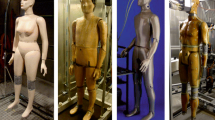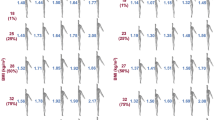Abstract
Recently, breathing thermal manikins have been developed and used for indoor environment measurement, evaluation and optimization as well as validation of the computational fluid dynamic predictions of airflow around a human body. Advances in the assessment of occupants’ thermal comfort and perceived air quality by means of breathing thermal manikins have also been made. In order to perform accurate measurements and realistic evaluation and assessment, the design and characteristics of a manikin must comply with certain requirements. The most important of these, such as the number, size and shape of body segments, control mode, breathing simulation etc., are discussed and specified in this paper.
Similar content being viewed by others
References
Bjørn E (1999) Simulation of human respiration with breathing thermal manikins. In: Proceedings of the 3rd international meeting on thermal manikin testing 3IMM, Stockholm, Sweden, 12–13 October 1999
Brohus H, Nielsen PV (1996) Personal exposure in displacement ventilated rooms. Indoor Air 6:157–167
Dear RJ de, Arens E, Hui Z, Oguro M (1997) Convective and radiative heat transfer coefficients for individual human body segments. Int J Biometeorol 40:141–156
Fang L, Clausen G, Fanger PO (1998) Impact of temperature and humidity on perception of indoor air quality during immediate and longer whole-body exposures. Indoor Air 8:276–284
ISO Standard 9920 (1995) Ergonomics of the thermal environment—estimation of the thermal insulation and evaporative resistance of a clothing ensemble. International Organization for Standardization, Geneva
ISO Standard 7730 (1998) Ergonomics of the thermal environment—instruments for measuring physical quantities. International Organization for Standardization, Geneva
Madsen T (1993) Thermal effects of ventilated car seats. In: Nielsen R, Joergensen K (eds) Advances in industrial ergonomics and safety V. Taylor and Francis, London, pp 411–418
Melikov AK, Zhou G (1996) Air movement at the neck of the human body. In: Proceedings of Indoor Air’96, vol I. Nagoya, Japan, 21–26 July 1996
Melikov A, Zhou H (1999) Comparison of methods for determining equivalent temperature under well-designed conditions. In: Proceedings of the 6th international conference Florence ATA. Florence, Italy, 1999
Melikov A, Kaczmarczyk J, Cygan L (2000) Indoor air quality assessment by a “breathing” thermal manikin. In: Awbi H (ed) Air distribution in rooms: proceedings of Roomvent 2000, vol I. Elsevier, London, pp 101–106
Melikov A, Cermak R, Mayer M (2002) Personalized ventilation: evaluation of different air terminal devices. Energy Buildings 34:829–836
Melikov A, Cermak R, Kovar O, Forejt L (2003) Impact of airflow interaction on inhaled air quality and transport of contaminants in rooms with personalized and total volume ventilation. In: Proceedings of Healthy Buildings 2003, Singapore, 7-1 National University of Singapore, Department of Building, vol 2, pp 592–597
Melikov A, Kaczmarczyk J, Cygan L (2004a) Indoor air quality assessment by a breathing thermal manikin. Indoor Air (in press)
Melikov A, Janicas NRJ, Silva MG da (2004b) A method for correction of manikin determined segmental equivalent temperature for error due to incomplete contact of the body with a surface. In: Proceedings of Roomvent 2004, Coimbra, Portugal, 5–8 September 2004
Nielsen PV (1999) The importance of thermal manikins as a source and obstacle in full-scale experiments. In: Proceedings of the 3rd international meeting on thermal manikin testing 3IMM, Stockholm, Sweden, 12–13 October 1999
Nilsson H, Holmer I (2003) Comfort climate evaluation with thermal manikin methods and computer simulation models. Indoor Air 13:28–37
Nilsson H, Holmer I, Bohm M, Noren O (1999) Definition and theoretical background of the equivalent temperature. In: Proceedings of the international ATA conference, Florence, 1999
Tanabe S, Arens EA, Bauman FS, Zhang H, Madsen TL (1994) Evaluating thermal environments by using a thermal manikin with controlled skin surface temperature. ASHRAE Trans 100:39–48
Wyon DP (1993) Healthy buildings and their impact on productivity. In: Proceedings of Indoor Air ‘93, vol 6. Helsinki, Finland, 1993
Author information
Authors and Affiliations
Corresponding author
Rights and permissions
About this article
Cite this article
Melikov, A. Breathing thermal manikins for indoor environment assessment: important characteristics and requirements. Eur J Appl Physiol 92, 710–713 (2004). https://doi.org/10.1007/s00421-004-1142-1
Accepted:
Published:
Issue Date:
DOI: https://doi.org/10.1007/s00421-004-1142-1




